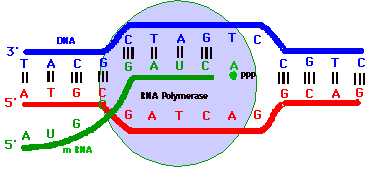Nucleic Acids and the Genetic Material Problem Set 1
Problem 15: DNA template for mRNA synthesis
| You have obtained a sample of DNA, and you transcribe mRNA from this DNA and purify it. You then separate the two strands of the DNA and analyze the base composition of each strand and of the mRNA. You obtain the data shown in the table to the right. Which strand of the DNA is the coding strand, serving as a template for mRNA synthesis? |
|
Summary of DNA transctiption

The diagram depicts DNA transcription. The coding strand of DNA in blue is used as a template for the mRNA shown in green. Complementary base pairing is used to determine the base sequence. A key feature is that the sequence and polarity of the mRNA is the same as the non-coding strand of DNA shown in red. Thus, since both the non-coding strand and the mRNA are transcribed from the same coding strand, their sequences are the same, except that U replaces T. In question 15, the correct answer has to be DNA strand #2. Strand #1 is non-coding since it has the same A, G, and C composition and has its T percentage equal to U of mRNA.
University of Arizona
Sunday, September 29, 1996
denicew@u.arizona.edu
http://www.biology.arizona.edu
All contents copyright © 1996. All rights reserved.





